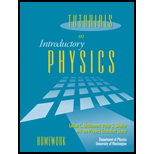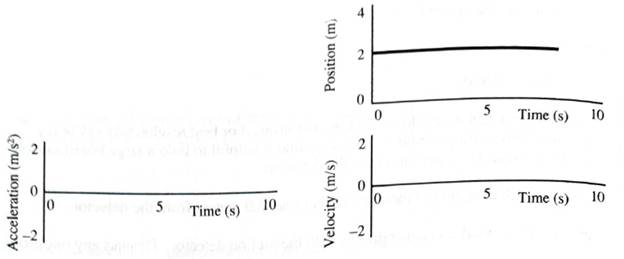
Tutorials In Introductory Physics: Homework
1st Edition
ISBN: 9780130662453
Author: Lillian C. McDermott, Peter S. Shaffer
Publisher: PEARSON
expand_more
expand_more
format_list_bulleted
Concept explainers
Textbook Question
Chapter 1.2, Problem 1bT
Description of Motion:

Expert Solution & Answer
Trending nowThis is a popular solution!
Learn your wayIncludes step-by-step video

schedule01:07
Students have asked these similar questions
Hi! I need help with these calculations for part i and part k for a physics Diffraction Lab. We used a slit width 0.4 mm to measure our pattern.
Examine the data and % error values in Data Table 3 where the angular displacement of the simple pendulum decreased but the mass of the pendulum bob and the length of the pendulum remained constant. Describe whether or not your data shows that the period of the pendulum depends on the angular displacement of the pendulum bob, to within a reasonable percent error.
In addition to the anyalysis of the graph, show mathematically that the slope of that line is 2π/√g . Using the slope of your line calculate the value of g and compare it to 9.8.
Chapter 1 Solutions
Tutorials In Introductory Physics: Homework
Ch. 1.1 - Each person in your group should obtain a ruler...Ch. 1.1 - Each person in your group should obtain a ruler...Ch. 1.1 - Each person in your group should obtain a ruler...Ch. 1.1 - Each person in your group should obtain a ruler...Ch. 1.1 - Each person in your group should obtain a ruler...Ch. 1.1 - Each person in your group should obtain a ruler...Ch. 1.1 - Each person in your group should obtain a ruler...Ch. 1.1 - A. In the space below, sketch a possible ticker...Ch. 1.1 - B. Together with your classmates, take your ticker...Ch. 1.1 - C. Based on your observations of your tape segment...
Ch. 1.1 - D. Review your earlier interpretation of the speed...Ch. 1.1 - E. Suppose you selected two widely separated dots...Ch. 1.2 - The computer program assumes a particular...Ch. 1.2 - Description of Motion:Ch. 1.2 - Description of Motion:Ch. 1.2 - Description of Motion:Ch. 1.2 - How are the motions in parts C and D similar? How...Ch. 1.2 - Description of Motion:Ch. 1.2 - Description of Motion:Ch. 1.2 - Description of Motion: Move toward the detector...Ch. 1.2 - How do the acceleration graphs for F, G, and H...Ch. 1.2 - Description of Motion: Initially move away from...Ch. 1.2 - Description of Motion:Ch. 1.2 - Description of Motion:Ch. 1.2 - The term decelerate is often used to indicate that...Ch. 1.3 - Draw vectors on your diagram that represent the...Ch. 1.3 - B. In the space at right, compare the velocities...Ch. 1.3 - Consider the change in velocity vector between two...Ch. 1.3 - Use the definition of acceleration to draw a...Ch. 1.3 - Does the acceleration change as the ball rolls up...Ch. 1.3 - Generalize your results thus far to answer the...Ch. 1.3 - Choose two successive points. In the space at...Ch. 1.3 - In the space at right, draw a vector to represent...Ch. 1.3 - Choose a point before the turnaround and another...Ch. 1.3 - Suppose that you had chosen the turnaround as one...Ch. 1.3 - In the space at right, draw a vector that...Ch. 1.4 - Prob. 1aTCh. 1.4 - If you were to choose a different origin for the...Ch. 1.4 - On a separate part of your paper, copy the...Ch. 1.4 - Suppose you were to choose a new point on the...Ch. 1.4 - On a separate part of your paper, copy the...Ch. 1.4 - Suppose the object started from rest at point E...Ch. 1.4 - At several points on each of the diagrams below,...Ch. 1.5 - The second diagram at right shows the positions of...Ch. 1.5 - The picture of the spaceships and shuttle from the...Ch. 1.5 - Prob. 1cTCh. 1.5 - Spaceship C moves so as to remain a fixed distance...Ch. 1.5 - Consider the following statement: "The...Ch. 1.5 - Prob. 1fTCh. 1.5 - Describe the motion of the car and the truck...Ch. 1.5 - Complete the diagram at right by drawing the car...Ch. 1.5 - Use your completed diagram to sketch average...Ch. 1.5 - During a small time interval t from just before to...
Additional Science Textbook Solutions
Find more solutions based on key concepts
Modified True/False 9. A giant bacterium that is large enough to be seen without a microscope is Selenomonas.
Microbiology with Diseases by Body System (5th Edition)
Two culture media were inoculated with four different bacteria. After incubation, the following results were ob...
Microbiology: An Introduction
Distinguish between microevolution, speciation, and macroevolution.
Campbell Essential Biology (7th Edition)
Explain all answers clearly, with complete sentences and proper essay structure if needed. An asterisk(*) desig...
Cosmic Perspective Fundamentals
What are the minimum and maximum ages of the island of Kauai? Minimum age: ______million yr Maximum age: ______...
Applications and Investigations in Earth Science (9th Edition)
47. A block hangs in equilibrium from a vertical spring. When a second identical block is added, the original ...
Physics for Scientists and Engineers: A Strategic Approach, Vol. 1 (Chs 1-21) (4th Edition)
Knowledge Booster
Learn more about
Need a deep-dive on the concept behind this application? Look no further. Learn more about this topic, physics and related others by exploring similar questions and additional content below.Similar questions
- An object is placed 24.1 cm to the left of a diverging lens (f = -6.51 cm). A concave mirror (f= 14.8 cm) is placed 30.2 cm to the right of the lens to form an image of the first image formed by the lens. Find the final image distance, measured relative to the mirror. (b) Is the final image real or virtual? (c) Is the final image upright or inverted with respect to the original object?arrow_forwardConcept Simulation 26.4 provides the option of exploring the ray diagram that applies to this problem. The distance between an object and its image formed by a diverging lens is 5.90 cm. The focal length of the lens is -2.60 cm. Find (a) the image distance and (b) the object distance.arrow_forwardPls help ASAParrow_forward
arrow_back_ios
SEE MORE QUESTIONS
arrow_forward_ios
Recommended textbooks for you
 College PhysicsPhysicsISBN:9781938168000Author:Paul Peter Urone, Roger HinrichsPublisher:OpenStax College
College PhysicsPhysicsISBN:9781938168000Author:Paul Peter Urone, Roger HinrichsPublisher:OpenStax College An Introduction to Physical SciencePhysicsISBN:9781305079137Author:James Shipman, Jerry D. Wilson, Charles A. Higgins, Omar TorresPublisher:Cengage Learning
An Introduction to Physical SciencePhysicsISBN:9781305079137Author:James Shipman, Jerry D. Wilson, Charles A. Higgins, Omar TorresPublisher:Cengage Learning Glencoe Physics: Principles and Problems, Student...PhysicsISBN:9780078807213Author:Paul W. ZitzewitzPublisher:Glencoe/McGraw-Hill
Glencoe Physics: Principles and Problems, Student...PhysicsISBN:9780078807213Author:Paul W. ZitzewitzPublisher:Glencoe/McGraw-Hill University Physics Volume 1PhysicsISBN:9781938168277Author:William Moebs, Samuel J. Ling, Jeff SannyPublisher:OpenStax - Rice University
University Physics Volume 1PhysicsISBN:9781938168277Author:William Moebs, Samuel J. Ling, Jeff SannyPublisher:OpenStax - Rice University College PhysicsPhysicsISBN:9781285737027Author:Raymond A. Serway, Chris VuillePublisher:Cengage Learning
College PhysicsPhysicsISBN:9781285737027Author:Raymond A. Serway, Chris VuillePublisher:Cengage Learning Principles of Physics: A Calculus-Based TextPhysicsISBN:9781133104261Author:Raymond A. Serway, John W. JewettPublisher:Cengage Learning
Principles of Physics: A Calculus-Based TextPhysicsISBN:9781133104261Author:Raymond A. Serway, John W. JewettPublisher:Cengage Learning

College Physics
Physics
ISBN:9781938168000
Author:Paul Peter Urone, Roger Hinrichs
Publisher:OpenStax College

An Introduction to Physical Science
Physics
ISBN:9781305079137
Author:James Shipman, Jerry D. Wilson, Charles A. Higgins, Omar Torres
Publisher:Cengage Learning

Glencoe Physics: Principles and Problems, Student...
Physics
ISBN:9780078807213
Author:Paul W. Zitzewitz
Publisher:Glencoe/McGraw-Hill

University Physics Volume 1
Physics
ISBN:9781938168277
Author:William Moebs, Samuel J. Ling, Jeff Sanny
Publisher:OpenStax - Rice University

College Physics
Physics
ISBN:9781285737027
Author:Raymond A. Serway, Chris Vuille
Publisher:Cengage Learning

Principles of Physics: A Calculus-Based Text
Physics
ISBN:9781133104261
Author:Raymond A. Serway, John W. Jewett
Publisher:Cengage Learning
Position/Velocity/Acceleration Part 1: Definitions; Author: Professor Dave explains;https://www.youtube.com/watch?v=4dCrkp8qgLU;License: Standard YouTube License, CC-BY